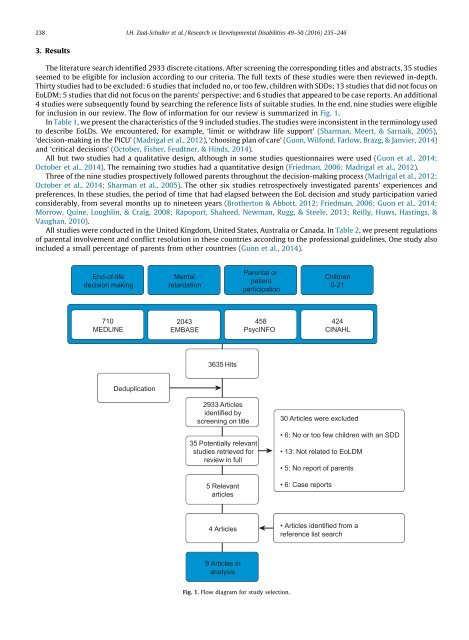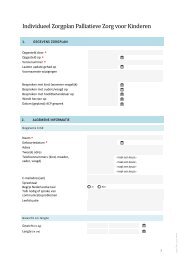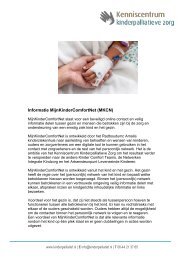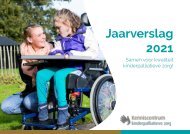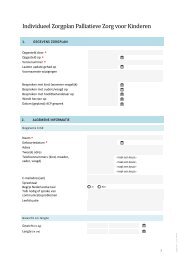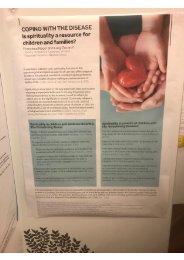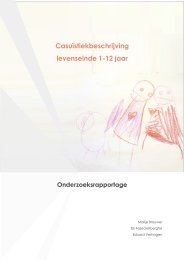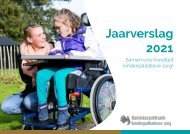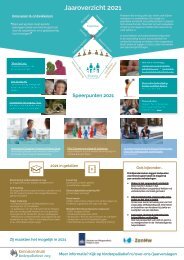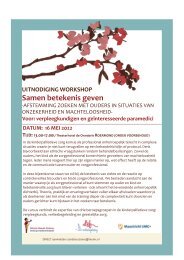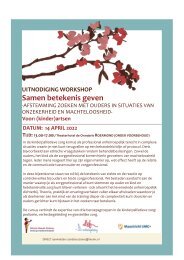End-of-life decision-making for children with severe developmental disabilities
Create successful ePaper yourself
Turn your PDF publications into a flip-book with our unique Google optimized e-Paper software.
238<br />
I.H. Zaal-Schuller et al. / Research in Developmental Disabilities 49–50 (2016) 235–246<br />
3. Results<br />
The literature search identified 2933 discrete citations. After screening the corresponding titles and abstracts, 35 studies<br />
seemed to be eligible <strong>for</strong> inclusion according to our criteria. The full texts <strong>of</strong> these studies were then reviewed in-depth.<br />
Thirty studies had to be excluded: 6 studies that included no, or too few, <strong>children</strong> <strong>with</strong> SDDs; 13 studies that did not focus on<br />
EoLDM; 5 studies that did not focus on the parents’ perspective; and 6 studies that appeared to be case reports. An additional<br />
4 studies were subsequently found by searching the reference lists <strong>of</strong> suitable studies. In the end, nine studies were eligible<br />
<strong>for</strong> inclusion in our review. The flow <strong>of</strong> in<strong>for</strong>mation <strong>for</strong> our review is summarized in Fig. 1.<br />
In Table 1, we present the characteristics <strong>of</strong> the 9 included studies. The studies were inconsistent in the terminology used<br />
to describe EoLDs. We encountered, <strong>for</strong> example, ‘limit or <strong>with</strong>draw <strong>life</strong> support’ (Sharman, Meert, & Sarnaik, 2005),<br />
‘<strong>decision</strong>-<strong>making</strong> in the PICU’ (Madrigal et al., 2012), ‘choosing plan <strong>of</strong> care’ (Guon, Wilfond, Farlow, Brazg, & Janvier, 2014)<br />
and ‘critical <strong>decision</strong>s’ (October, Fisher, Feudtner, & Hinds, 2014).<br />
All but two studies had a qualitative design, although in some studies questionnaires were used (Guon et al., 2014;<br />
October et al., 2014). The remaining two studies had a quantitative design (Friedman, 2006; Madrigal et al., 2012).<br />
Three <strong>of</strong> the nine studies prospectively followed parents throughout the <strong>decision</strong>-<strong>making</strong> process (Madrigal et al., 2012;<br />
October et al., 2014; Sharman et al., 2005). The other six studies retrospectively investigated parents’ experiences and<br />
preferences. In these studies, the period <strong>of</strong> time that had elapsed between the EoL <strong>decision</strong> and study participation varied<br />
considerably, from several months up to nineteen years (Brotherton & Abbott, 2012; Friedman, 2006; Guon et al., 2014;<br />
Morrow, Quine, Loughlin, & Craig, 2008; Rapoport, Shaheed, Newman, Rugg, & Steele, 2013; Reilly, Huws, Hastings, &<br />
Vaughan, 2010).<br />
All studies were conducted in the United Kingdom, United States, Australia or Canada. In Table 2, we present regulations<br />
<strong>of</strong> parental involvement and conflict resolution in these countries according to the pr<strong>of</strong>essional guidelines. One study also<br />
included a small percentage <strong>of</strong> parents from other countries (Guon et al., 2014).<br />
[(Fig._1)TD$FIG]<br />
<strong>End</strong>-<strong>of</strong>-<strong>life</strong><br />
<strong>decision</strong> <strong>making</strong><br />
Mental<br />
retardation<br />
Parental or<br />
patient<br />
participation<br />
Children<br />
0-21<br />
710<br />
MEDLINE<br />
2043<br />
EMBASE<br />
458<br />
PsycINFO<br />
424<br />
CINAHL<br />
3635 Hits<br />
Deduplication<br />
2933 Articles<br />
identified by<br />
screening on title<br />
35 Potentially relevant<br />
studies retrieved <strong>for</strong><br />
review in full<br />
5 Relevant<br />
articles<br />
30 Articles were excluded:<br />
• 6: No or too few <strong>children</strong> <strong>with</strong> an SDD<br />
• 13: Not related to EoLDM<br />
• 5: No report <strong>of</strong> parents<br />
• 6: Case reports<br />
4Articles<br />
• Articles identified from a<br />
reference list search<br />
9Articles in<br />
analysis<br />
Fig. 1. Flow diagram <strong>for</strong> study selection.


